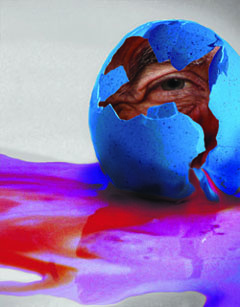Diving into the Dark
Theatrical stories are often told through a series of dialogue between actors. But what if they were told only through sound and physical action?
This idea is captured in the “Crystal Egg” production, set to run December 2-5, 10-13, in the UMBC Theatre. However, the movements are not made by actors – but handcrafted and manually operated puppets. And the sounds are not only made by instruments – but everyday objects such as wine glasses or children’s toys.
The production is a collaborative effort between theatre students and Imaging Research Center (IRC) Fellows, spurred from a discussion between Colette Searls, director of the “Crystal Egg” and associate professor of theatre, and Tim Nohe, associate professor of visual arts.
“I had worked with the IRC before and was already extremely interested in computer puppetry,” said Searls. “When Tim approached me about the project, I decided to conceive a new play that integrated traditional hand-manipulated puppets with animated characters.”
An original piece of science-fiction theatre inspired by H.G. Wells’s “Crystal Egg” story, the “Crystal Egg” is about a man who discovers creatures from another dimension inside an antique crystal egg. The play combines puppetry and live-action animation.
“The majority of the semester has been spent conceiving, designing and programming the animated creatures that escape from the egg,” said Searls. “This has required a team-based approach to artistic and logical problem-solving.”
Some students have worked as lead 3-D artists, perfecting the character and appearance of the puppets, while others have programmed actions to make them appear life-like and spontaneous. Along the way, the students discovered a method that would allow the puppets to be operated in real time, through use of video game controllers.
When it comes to the sound score for the “Crystal Egg,” the composition is a mix of traditional instruments of the orchestra (like the viola and harp) with everyday objects. The harp is performed by an undergraduate student, and the strings are performed by Professor of Mechanical Engineering Tim Topoleski. Other instrumentation is done by Nohe and the Imaging Research Center Fellows.
“They are all intermixed and radically transformed in a laptop to produce undercurrents of surreal darkness,” said Nohe.
That darkness translates not only from the stage but also from the conception of the collaboration. The “diving into the dark” experience was new for almost everyone involved, according to Searls.
A performance schedule and ticket information are available online.
(11/20/09)

